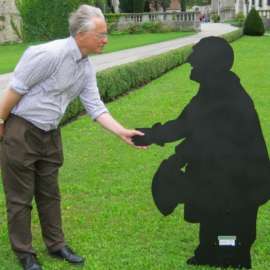The two masses in this intriguing and very enjoyable programme made a thought-provoking contrast. Stravinsky was anxious that his mass be cold – indeed, as the bass singer Simon Scott Plummer’s useful programme notes told us, he wanted the music ‘very cold, absolutely cold, that will appeal directly to the spirit.’ Bruckner’s E minor mass was composed originally for outdoor performance, but that’s the only source of any coldness that might attach to his work, full as it is of heated expressive gestures that might also ‘appeal directly to the spirit’. There is in the two works a different attitude to religious text and how it might best be transmitted, though a difference that perhaps was not fully explored in these performances.
The Kyrie eleison is a curiously jaunty plea for mercy in Stravinsky’s setting, energised by angular interpolations from the wind band. The chamber choir Canticum sing with immense beauty and – I can find no other word – warmth, so that in the Gloria their rigid chanting seemed hardly cold and severe enough. It is a wonderfully sonorous choir, and when in full voice, singing at their loudest, as for example in ‘Pleni sunt caeli’ (‘Heaven and earth are full of thy glory’), the sound is luminescent and spine-tingling. Together with Stravinsky’s extraordinary orchestration, the mix between this beautiful choral singing and wind band was riveting to hear, the balance between voices and instruments well judged – I remember especially the Benedictus, the wonderful colour evoked when in slow, sustained music the choir was bracketed between high and low wind instruments. It’s not a work I am familiar enough with to give detailed criticism of the performance, but to the innocent ear it came over very powerfully, full of varied colour and energetic projection.
The Bruckner mass too was very beautifully and strongly sung; the dramatic fortissimos and silences registered with full power in the church acoustic with its atmospheric reverberation. The sheer beauty of the choir, its balance and sure intonation, and its concentration, ensure that there is never a moment that is merely routine or fails to register, and this made for a glowing and exciting performance. But I felt that conductor Mark Forkgen was too apt to rely on his choir’s strengths and stormed mellifluously through Bruckner’s score with scant attention to the composer’s very precise layering of dynamics. They range from ppp to fff, with some long crescendos but more often than not contrasted blocks of sound of differing dynamics – but these distinctions were often ignored to the detriment of Bruckner’s music and its ability to ‘appeal directly to the spirit’. The quieter passages suffered most. Just two examples might give some indication of how the performance handled this music: the ‘Et incarnatus est’ (Adagio), marked p, has a diminuendo marked over ‘Maria’ down to pp for ‘virgine’, rising immediately to p for ‘et homo factus est’. To make its full effect and carry the significance Bruckner attached, ‘virgine’ should surely be really hushed, but it was all done in the mp, even mf range – beautiful, but without the tenderness and burden of meaning. And the Sanctus begins with 26 bars 8-part a cappella, the dynamic (in German) requiring that it be sung with moderate strength, but afterwards building up more and more – in other words, it is a very long crescendo reaching a fff plateau on ‘Domine Deus Sabaoth’, which dynamic is maintained over an equal 26 bars to the end of the movement. Mark Forkgen had his choir begin something like mf, and within a dozen bars they were already at fff. When singing loudly, they are wonderful, and the intricate counterpoint and clear layering of voices was achieved tremendously, but the simple dramatic power of the dynamic structure of this movement was lost due to the absence of a carefully graded and lengthy first-half crescendo.
In between the two works, wind players from the Southbank Sinfonia, an orchestra of ‘young professionals’, treated us to a splendid performance of Mozart’s C minor serenade, a strangely ambiguous work that begins as though it might inhabit the trenchant world of the C minor piano concerto, but lightens up considerably as it goes along. There was one of those magical coincidences: as the performance passed from the C minor opening movement to the E major clarinet melody of the second movement, the evening sun broke through the clouds and lit up the internal walls of St Martin’s. The closing theme and variations movement was an absolute joy, all the performers displaying winning virtuosity, but especially the oboe’s speedy triplet variation, and that final eerie transition that breaks out into the jolly C major coda.
I came away from the concert happy, and very impressed, that I'd heard such beautiful music-making, but feeling that the full range of the choral music's potential had perhaps not been addressed as searchingly as it might have been, given the excellence of the performers at the conductor's disposal.


